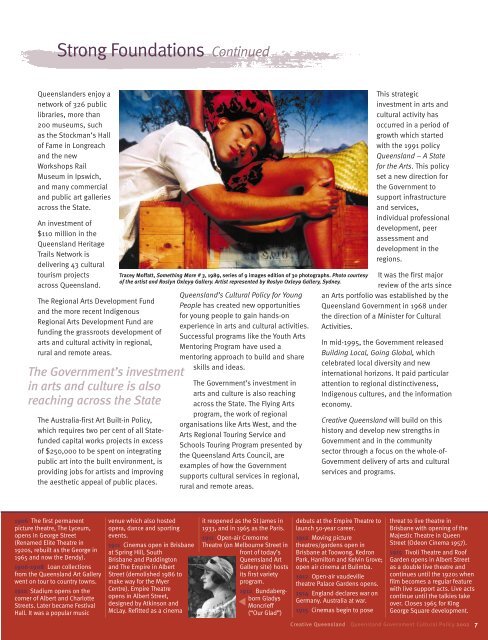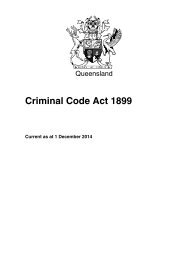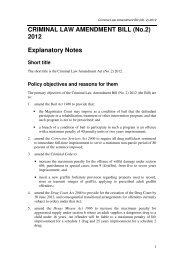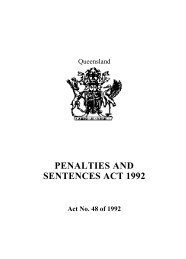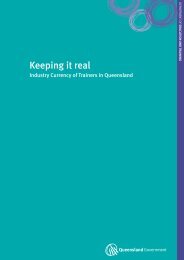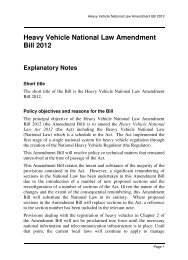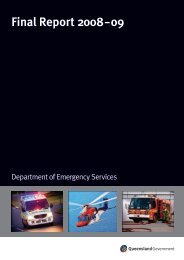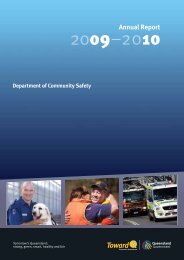AQ034 Cultural Policy.qxd - Arts Queensland
AQ034 Cultural Policy.qxd - Arts Queensland
AQ034 Cultural Policy.qxd - Arts Queensland
- No tags were found...
Create successful ePaper yourself
Turn your PDF publications into a flip-book with our unique Google optimized e-Paper software.
Strong Foundations Continued<br />
<strong>Queensland</strong>ers enjoy a<br />
network of 326 public<br />
libraries, more than<br />
200 museums, such<br />
as the Stockman’s Hall<br />
of Fame in Longreach<br />
and the new<br />
Workshops Rail<br />
Museum in Ipswich,<br />
and many commercial<br />
and public art galleries<br />
across the State.<br />
An investment of<br />
$110 million in the<br />
<strong>Queensland</strong> Heritage<br />
Trails Network is<br />
delivering 43 cultural<br />
tourism projects<br />
across <strong>Queensland</strong>.<br />
The Regional <strong>Arts</strong> Development Fund<br />
and the more recent Indigenous<br />
Regional <strong>Arts</strong> Development Fund are<br />
funding the grassroots development of<br />
arts and cultural activity in regional,<br />
rural and remote areas.<br />
The Government’s investment<br />
in arts and culture is also<br />
reaching across the State<br />
The Australia-first Art Built-in <strong>Policy</strong>,<br />
which requires two per cent of all Statefunded<br />
capital works projects in excess<br />
of $250,000 to be spent on integrating<br />
public art into the built environment, is<br />
providing jobs for artists and improving<br />
the aesthetic appeal of public places.<br />
Tracey Moffatt, Something More # 3, 1989, series of 9 images edition of 30 photographs. Photo courtesy<br />
of the artist and Roslyn Oxley9 Gallery. Artist represented by Roslyn Oxley9 Gallery, Sydney.<br />
<strong>Queensland</strong>’s <strong>Cultural</strong> <strong>Policy</strong> for Young<br />
People has created new opportunities<br />
for young people to gain hands-on<br />
experience in arts and cultural activities.<br />
Successful programs like the Youth <strong>Arts</strong><br />
Mentoring Program have used a<br />
mentoring approach to build and share<br />
skills and ideas.<br />
The Government’s investment in<br />
arts and culture is also reaching<br />
across the State. The Flying <strong>Arts</strong><br />
program, the work of regional<br />
organisations like <strong>Arts</strong> West, and the<br />
<strong>Arts</strong> Regional Touring Service and<br />
Schools Touring Program presented by<br />
the <strong>Queensland</strong> <strong>Arts</strong> Council, are<br />
examples of how the Government<br />
supports cultural services in regional,<br />
rural and remote areas.<br />
This strategic<br />
investment in arts and<br />
cultural activity has<br />
occurred in a period of<br />
growth which started<br />
with the 1991 policy<br />
<strong>Queensland</strong> – A State<br />
for the <strong>Arts</strong>. This policy<br />
set a new direction for<br />
the Government to<br />
support infrastructure<br />
and services,<br />
individual professional<br />
development, peer<br />
assessment and<br />
development in the<br />
regions.<br />
It was the first major<br />
review of the arts since<br />
an <strong>Arts</strong> portfolio was established by the<br />
<strong>Queensland</strong> Government in 1968 under<br />
the direction of a Minister for <strong>Cultural</strong><br />
Activities.<br />
In mid-1995, the Government released<br />
Building Local, Going Global, which<br />
celebrated local diversity and new<br />
international horizons. It paid particular<br />
attention to regional distinctiveness,<br />
Indigenous cultures, and the information<br />
economy.<br />
Creative <strong>Queensland</strong> will build on this<br />
history and develop new strengths in<br />
Government and in the community<br />
sector through a focus on the whole-of-<br />
Government delivery of arts and cultural<br />
services and programs.<br />
1906 The first permanent<br />
picture theatre, The Lyceum,<br />
opens in George Street<br />
(Renamed Elite Theatre in<br />
1920s, rebuilt as the George in<br />
1965 and now the Dendy).<br />
1906-1908 Loan collections<br />
from the <strong>Queensland</strong> Art Gallery<br />
went on tour to country towns.<br />
1910 Stadium opens on the<br />
corner of Albert and Charlotte<br />
Streets. Later became Festival<br />
Hall. It was a popular music<br />
venue which also hosted<br />
opera, dance and sporting<br />
events.<br />
1911 Cinemas open in Brisbane<br />
at Spring Hill, South<br />
Brisbane and Paddington<br />
and The Empire in Albert<br />
Street (demolished 1986 to<br />
make way for the Myer<br />
Centre). Empire Theatre<br />
opens in Albert Street,<br />
designed by Atkinson and<br />
McLay. Refitted as a cinema<br />
53950<br />
it reopened as the St James in<br />
1933, and in 1965 as the Paris.<br />
1911 Open-air Cremorne<br />
Theatre (on Melbourne Street in<br />
front of today’s<br />
<strong>Queensland</strong> Art<br />
Gallery site) hosts<br />
its first variety<br />
program.<br />
1912 Bundabergborn<br />
Gladys<br />
Moncrieff<br />
(“Our Glad”)<br />
▼<br />
debuts at the Empire Theatre to<br />
launch 50-year career.<br />
1912 Moving picture<br />
theatres/gardens open in<br />
Brisbane at Toowong, Kedron<br />
Park, Hamilton and Kelvin Grove;<br />
open air cinema at Bulimba.<br />
1912 Open-air vaudeville<br />
theatre Palace Gardens opens.<br />
1914 England declares war on<br />
Germany. Australia at war.<br />
1915 Cinemas begin to pose<br />
threat to live theatre in<br />
Brisbane with opening of the<br />
Majestic Theatre in Queen<br />
Street (Odeon Cinema 1957).<br />
1915 Tivoli Theatre and Roof<br />
Garden opens in Albert Street<br />
as a double live theatre and<br />
continues until the 1920s when<br />
film becomes a regular feature<br />
with live support acts. Live acts<br />
continue until the talkies take<br />
over. Closes 1965 for King<br />
George Square development.<br />
Creative <strong>Queensland</strong> <strong>Queensland</strong> Government <strong>Cultural</strong> <strong>Policy</strong> 2002 7


